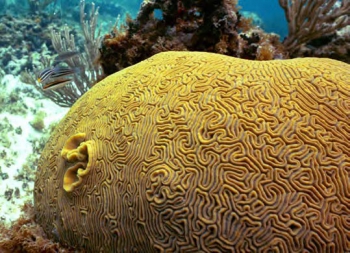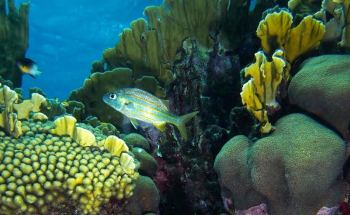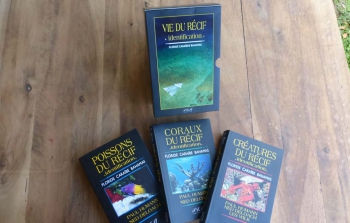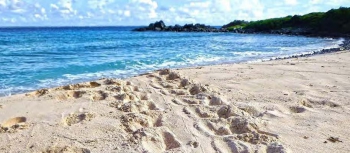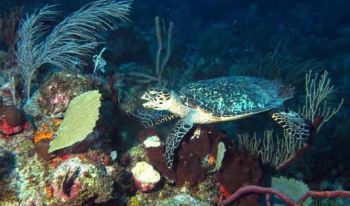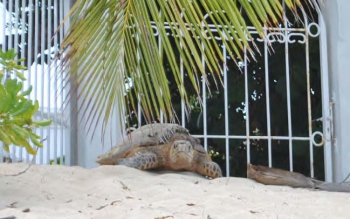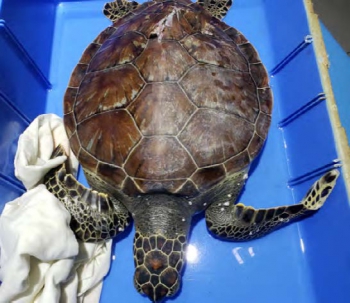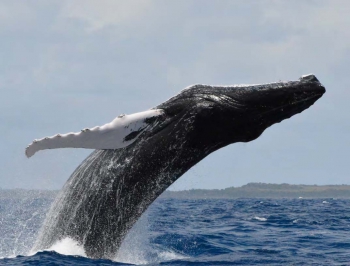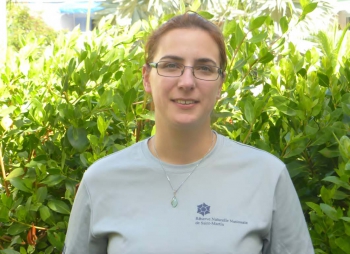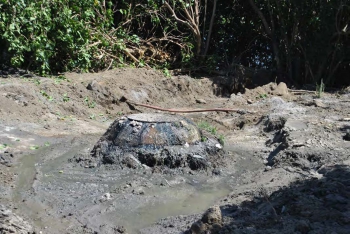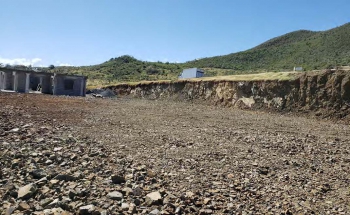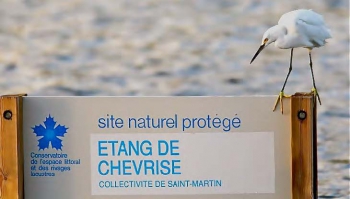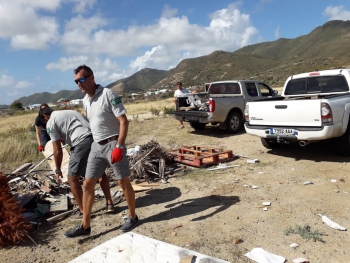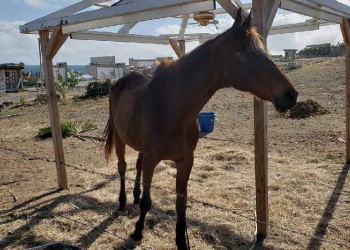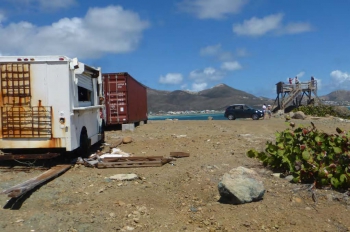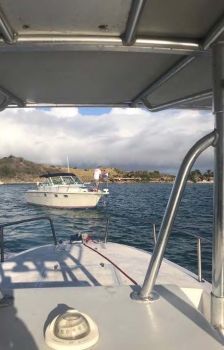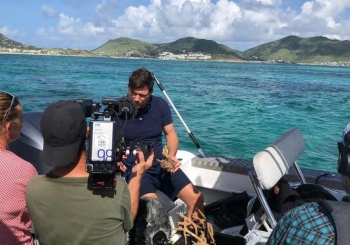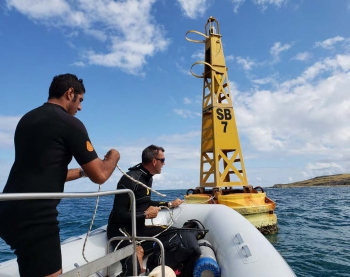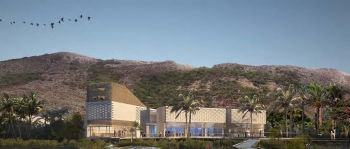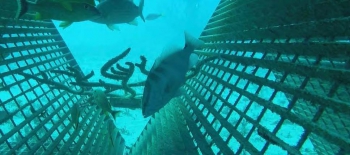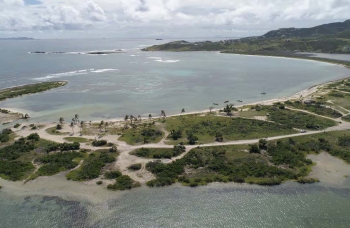IFRECOR—French Initiative For Coral Reefs— selected Saint Martin as the location for its twelfth national committee meeting, June 3-7, 2019, and asked the Réserve Naturelle to handle the onsite organization. Approximately 35 people are expected to attend, from France and overseas locations. A few local personalities will be invited to participate at the official opening, to be held at the CCISM on Monday, June 3. International and regional updates on the state of the coral reefs are on the agenda, as well as new topics suggested by committees in the Antilles. Working in smaller groups, the next few days will be dedicated to problems concerning the conservation of the coral reefs. The effects of climate change in tropical zones and the resulting impact on development of littoral areas will be presented, as will MERCI, the method to avoid, reduce, and compensate for such impact on natural sites. The ultimate goal is to define technical recommendations to avoid further degradation to our lifestyle and our natural environment.
Journal-34
Journal-34
To promote the conservation of the coral reefs and related species
Every year, between 15,000 and 20,000 tons of suntan lotion end up in the world’s oceans. This represents—along with global warming—one of the principal causes of coral bleaching. These chemical, toxic products, intended to protect our skin from UV rays, are like poison for the coral, as they modify its DNA and cause new shoots to die without the opportunity to develop. Information is getting out, so that consumers are asking for new kinds of sunscreens that are 100% organic and respect the environment. The Réserve Naturelle encourages swimmers to use these new products and will soon sign a sponsoring agreement with Alphanova. Located in Hyères (France), this company has developed suntan lotions that respect the environment, and they approached the Réserve in Saint Martin, offering to donate 1% of their worldwide sales of such products. In exchange, the Réserve is committed to the restoration of the coral in its marine zones, primarily by planting cuttings, and to direct diving and other tourist activities to certain areas, in order to give a rest to those sites that have too many visitors. Staff members from Alphanova will participate in these projects and the company will provide their suntan lotion and anti-UV clothing to the Réserve. At the same time, the Réserve will raise awareness with diving clubs, asking them to forbid chemical sunscreens at dive sites.
PLB, a publisher in Guadeloupe” has republished the collection, “La vie du récif” (Life Of A Reef), a boxed set containing three books: one on fish; one on coral; and one on creatures of the reef. Very popular with divers and underwater naturalists, these guides allow for the identification of species seen in the ocean and were designed for all who are passionate about marine life. They were updated for the occasion, and all of the managers of protected marine zones were asked to participate. Detailed information about the Réserve Naturelle of Saint Martin is included, as well as various aspects about the island such as underwater diving practices. The Réserve also happily shared its expertise on growth from coral cuttings and the creation of artificial habitats.
To promote the conservation of the sea turtle population
In spite of the fact that it was a busy year in terms of reconstruction, the egg-laying season for sea turtles was observed as usual from March through November 2018. The team of eco-volunteers that covers the beaches in the hope of seeing traces of a turtle come to lay its eggs was reduced to 30 people in 2018. By early June, no traces had been seen but it was not call for alarm. In fact, at the time of this report, no fewer than 104 traces had been reported after 288 patrols were done. That does not mean that the turtles were less present on our beached in 2018. However it seems wise to take extra care of these turtles, in context of the fact that a majority of the eggs laid in 2017 were destroyed by hurricane Irma, and certain building sites currently impact egg-laying areas. The reconstruction of Saint Martin should take into consideration the restoration of these egg-laying sites.
Julien Chalifour, who runs the turtle network in Saint Martin, also took part in the 3rd colloquium of the Sea Turtle Group of France, at the La Rochelle Aquarium on November 12-16 2018. Approximately 100 experts from France, the Atlantic Ocean, the Pacific Ocean, the Caribbean Sea and the Indian Ocean shared respective experiences in terms of conservation and the study of sea turtles, as well as their washing up on shore. This meeting has been for Julien Chalifour an opportunity to discuss ideas on subjects of interest to Saint Martin, notably the absence of treatment center for turtles that are sick or in distress, as compared to Reunion Island or Polynesia, where there are consequent structures that are financially independent. Another problem is that of turtle watching during underwater excursions, which can bother these protected reptiles and eventually cause them to flee, as well as cause an outbreak of diseases.
On January 25, the Réserve Naturelle was questioned by the gendarmerie, which required its expertise in the context of several ongoing issues that involve work on certain beaches, in particular in the Lowlands, in order to estimate the damage that this work could cause to egg-laying sites for sea turtles. In fact, the reconstruction of the island post-Irma often encouraged owners of land along the beach to build walls along the shoreline, without realizing they were causing a problem for the reproduction of sea turtles by destroying their natural habitat, as turtles nest at the top edge of the beach. As all sea turtles and their essential habitats for reproduction and feeding are protected, the equipment and machines that served to break the law could eventually be seized.
An injured turtle was spotted on February 19 in the bay of Marigot—where boat speeds are limited to three knots—by the personnel of Marina Fort Louis and Tradewind Charters, who immediately informed the Réserve Naturelle. The agents recovered the young green sea turtle, which was still alive, but signs of a violent impact with a boat propeller could be seen on its shell. An examination by a veterinarian showed that the spinal column of the animal had been ruptured. The turtle was paralyzed on the rear half of it body, thus unable to swim or reproduce. The only chance for survival would have been in an artificial basin of water for a long convalescence with uncertain results, but lacking a center for such treatment of marine animals in Saint Martin, the turtle was euthanized. This is the sixth known victim of collisions with boats since the 1st of January. Knowing that only one turtle in every thousand has a chance to reach adulthood, 20 to 25 years after it is hatched, it is essential to reduce the speed of all boats, as well as jet skis, especially near the shore and near underwater plant beds that serve as alimentation zones for sea turtles. Collisions with motorized vehicles and poachers are the two prime causes of mortality for sea turtles in Saint Martin.
To maintain or improve local conditions for marine mammal populations
Six beacons deployed, eight skin samples taken, a dozen photos of tail fins, and numerous recording of males singing. That recaps the positive results of Megara 4. MEGARA 4:
A Success! Maintenir ou améliorer les conditions d’accueil pour les populations de mammifères marins To maintain or improve local conditions for marine mammal populations Launched in 2014 by Nicolas Maslach as a scientific mission to study humpback whales, the fourth edition of MEGARA was held March 16-30 in the waters of Sint Maarten, Anguilla, Saint Barth, Saba, and Sint Eustatius, with proper authorization from these islands. The goal remains to develop a better understanding of the biology of these Caribbean humpback whales, notably through the deployment of Argos beacons, doing skin biopsies, recording the songs of the males, and taking photos of caudal fins for individual identification. Funded by the Réserve Naturelle, the association Megaptera, the Territorial Agency For The Environment in Saint Barth, and companies Nagico and Teria, at least one beacon was implanted in the fatty tissue of each of six humpback whales, and satellites are currently following the movements of four of these majestic mammals. This reveals that one of the whales is heading toward North America, and another is heading to Europe, but also that two females accompanied by their calves are moving around the neighboring islands, perhaps waiting for their babies get a bit bigger before starting the long migration toward summer feeding zones in the North Atlantic.
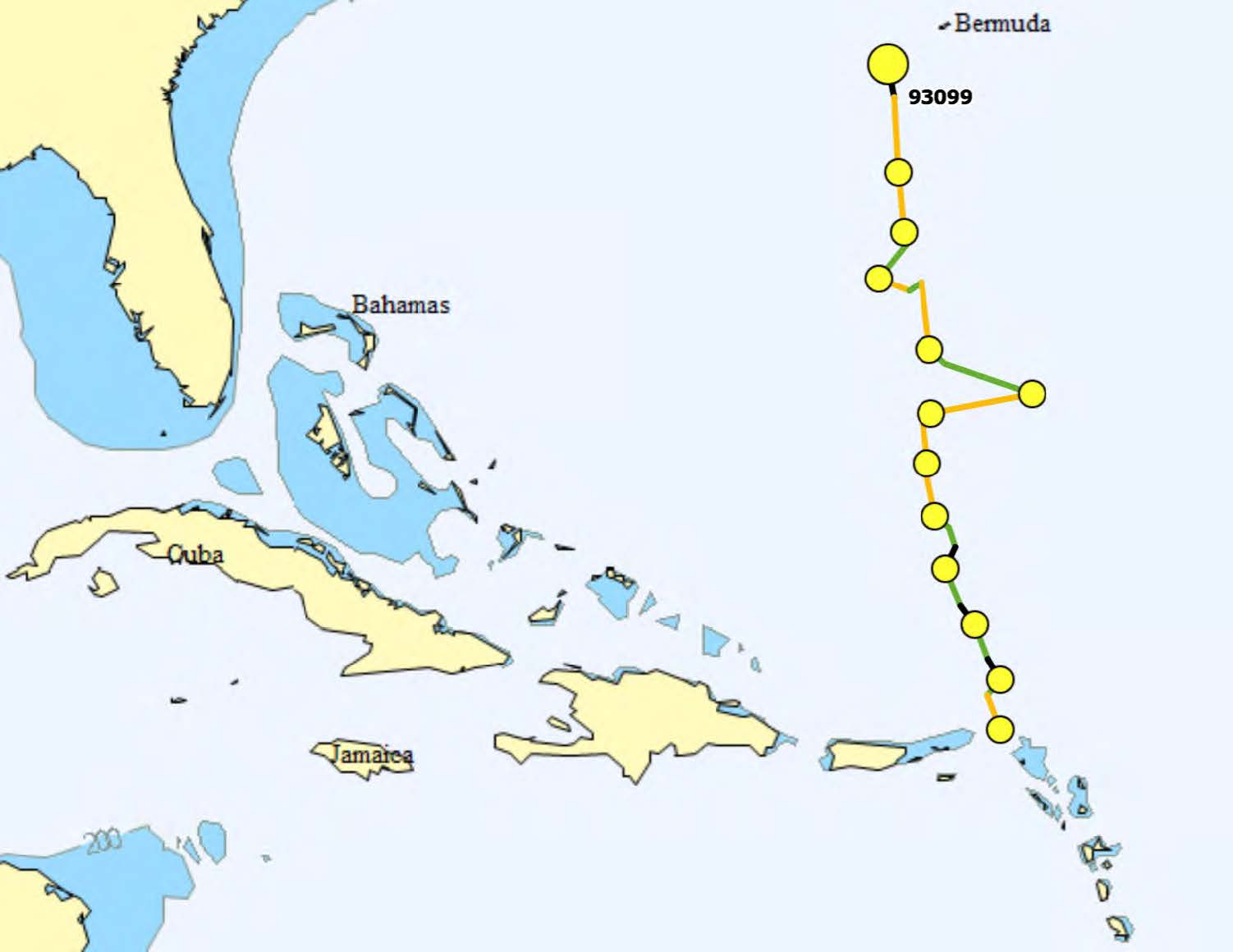
In addition, eight skin samples will provide genetic analyses that reveal the sex of each animal, and will be compared to the knowledge already acquired and centralized at The University of Groningen in the Netherlands, in an attempt to show that the “Saint Martin whales” are close genetically to those of Cape Verde. A dozen photos of caudal tail fins, whose characteristics define the identity of each humpback whale, will enrich the catalogue created in 2014 by the Réserve and will be shared with existing catalogues in the Caribbean as well as the United States, Canada, Iceland, and Norway, thanks to the support of OMMAG (Observatory For Marine Mammals In The Guadeloupe Archipelago). As for the songs of the males, intended to seduce the females, they differ from season to season. It is possible to hear a sample on the Réserve’s facebook page. The mission took place aboard a Contender and semi-rigid boat belonging to the Réserve, equipped with a turret used by Mikkel Villum Jensen, a professional whale tagger, to deploy his beacons, and for the staff of the Réserve to take the skin samples. A catamaran served as the logistical base for these operations. In spite of mediocre sea conditions, at least four groups of humpback whales were observed each day and provided beautiful aerial images taken from a drone. The staff of the Réserve Naturelle de Saint-Martin; Michel Vély, a marine mammals specialist and president of the Megaptera association; Steeve Ruillet, a member of Megaptera; the Territorial Agency For The Environment in Saint Barth; representatives from the Agoa sanctuary; and the European Cariman project; as well as several journalists, participated in this exceptional occasion marked by the sharing of knowledge and friendship.
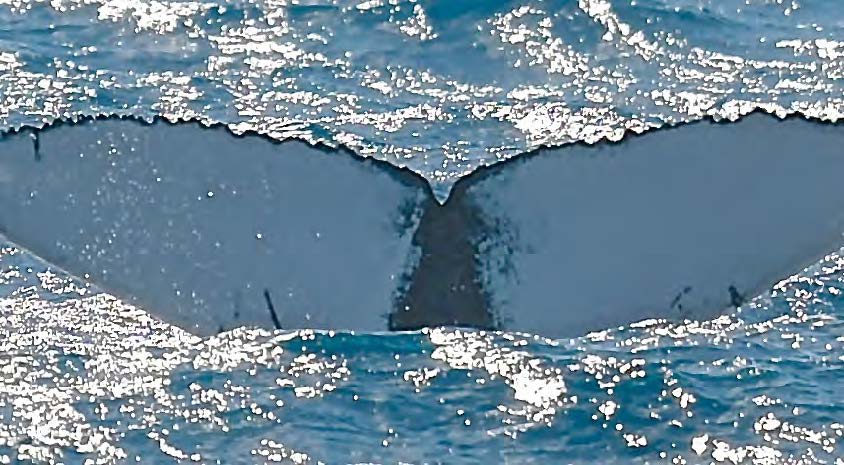
To maintain or improve local conditions for nesting bird populations
A student at the Paul Sabatier University in Toulouse, Camille Sanchez has been working with the Réserve Naturelle since February 18 and will remain through mid-August. At the age of 28, she decided to study “Man & Biosphere” (MAB) as part of her master’s program in biodiversity management. In the spirit of UNESCO’s MAB program, this training requires knowledge of interactions between human activities and ecological systems, for a more sustainable management of natural resources. Her mission in Saint Martin consists of studying the populations of shorebirds that feed on the salt ponds, adding a sociological take to this scientific study.
To maintain or improve the ecological health of the salt ponds
On May 1, the local branch of the Conservatoire du Littoral will meet with a civil service volunteer who will work on a two-year recovery project for the salt ponds in Saint Martin. A management committee will be formed to run the project, which will confront all of the current problems with the ponds: flooding, dumping of wastewater, debris... The goals are to recreate the original perimeters of the ponds, and most importantly validate the property boundaries with the land registry, before restoring the shores, as well as rebuilding the bird observatories and the wooden walkways destroyed by Irma, within a period of three years. The project also calls for a study of the water quality.
As residents were complaining about loud noise and debris between the main road and the Etang de Chevrise, agents from the Réserve Nnaturelle went to see what the problem was. There they could see that a mechanical shovel had dug between three and four meters deep, close to the funeral parlor, and a large volume of earth and rubble had been used to fill in below the pond, but not where the water is, and that area belongs to the Conservatoire du Littoral and is managed by the Réserve. Yet the nature of the material, especially in case of heavy rain, represents a real threat of creating silt in the pond, and the Réserve remains vigilant in its surveillance of this worksite. Additional expertise will determine if such encroachment by depositing such materials on land already classified under a biotope protection order is possible, and see what to do about it.
- A management committee for the local branch of the Conservatoire du Littoral will meet on April 2, 2019. Taking part will be the Réserve Naturelle as manager of Conservatoire’s sites, local officials, members of the Conseil des Rivages, the Tourist Office, the water and sanitation office, and the government as well as the DEAL
- The Conseil des rivages français d’Amérique (Council for French shores in the Americas) of the Conservatoire du Littoral will meet in Saint Martin on June 17-21. A total of 80 members are expected to attend, primarily to validate projects presented by branches in Guyana, Martinique, Guadeloupe, Saint Barth, and Saint Martin
- The 2006-2018 management agreement between the Réserve Naturelle and the Conservatoire du Littoral is coming to an end, and will soon be renewed for another nine years. The new agreement will focus more on the Réserve’s management activities.
- The call for proposals for the management of the Galion equestrian center will go out soon, with an eye toward reestablishing horseback riding at the site.
Why bother to take your dumpster full of trash to the eco-site—and pay a modest fee to dispose of it properly—when it’s just as easy to discretely dump it along the route du Galion, in the Réserve Naturelle? But not with complete impunity! Bad luck for the driver of this truck, as a witness wrote down his license number and immediately called the Réserve, which recorded the offense and transmitted its report to the nautical brigade. Papers in the name of the owner were found in the trash, and this person explained that he had asked a local company to empty his apartment in the Residence Belvédère, which had been destroyed by Irma. The owner of the truck and his client had an audience with nautical brigade and the affair was transferred to the public prosecutor. A 3,000€ invoice for the cleanup was attached to the file.
The agents of the Réserve cleaned up this unauthorized dump with the help of the employees of EME, the company that cleans Galion Beach, as part of an agreement with the Réserve Naturelle, the Conservatoire du Littoral and the Collectivity. Considering the amount of work to do and the lack of civism by certain people, the two days per week that the company dedicated to Galion have been increased to three days based on a decision made by the services of the Collectivity, following repeated requests by those who use the site.
Keeping an eye on the regulations and the level of human activities compatible with the goals of La Réserve
Residents notified the Réserve Naturelle when they saw a horse on the land at Babit Point— land that belongs to the Conservatoire du Littoral and is managed by the Réserve. The veterinary services went to see about the horse, accompanied by agents of the Réserve and territorial police. Brought to the site by its owner, a resident of Oyster Pond, the animal had been left in an enclosure made of rebar and barbed wire, in the full sun, close to a shelter without a roof implanted illegally by its master. Present during the control, the owner was informed that he was using land belonging to the Conservatoire du Littoral without authorization. He explained that he had to quickly remove his horse from its previous quarters, and that he planned to move it again soon, but not sooner than two months. He was told he had a short window to contact the owner and request temporary use of the site—otherwise the horse must be removed. He opted to move his horse to private land that had the same conditions, but leaving behind the enclosure and the shelter. Existing regulations forbid leaving equines in the open air without providing the proper facilities to avoid any suffering in case of climatic variations. It is also illegal to place animal or vegetal species on a protected natural site.
A lot of criticism has been directed at the Réserve Naturelle, claiming “they aren’t doing anything,” when it comes to the container sitting on the side of the Coralita road, in the parking lot for the whale observatory. However, the container is sitting on private land and the Réserve is not authorized to act. The Operations Committee of the Environmental and Urbanism Police (COPOLENU) discussed the issue at great length to rule on the jurisdiction of the Collectivity in this matter. The Collectivity then sent a letter to the owner of the property. Stay tuned for the end of the story.
Called by the CROSS Antilles Guyana on February 15 close to 1:30pm, two agents of the Réserve Naturelle went to the rescue of two boaters in danger within the waters of the Réserve. Coming from the Dutch side toward Pinel aboard their 40’ cabin with its two powerful motors, the two men aboard went too close to the reef at Grandes Cayes and hit the coral reef before finding themselves immobilized and unable to maneuver, taking a lot of water into the hull and their propellers bent. Franck Roncuzzi and Julien Chalifour leapt to their aid aboard the Contender belonging to the Réserve and succeeded in towing the boat as far as the bay in Cul-de-Sac. The owner, an 82 year-old American, spent the night aboard to avoid having his boat sink, and had it towed the next day to a shipyard in the lagoon.
Ensuring environmental communication, awareness, and education
Shown on France 3 TV on March 20,2019 and presented by Fanny Agostini, Thalassa’s “Facing The Anger Of The Sea” dedicated a large part of its program to Irma “an unprecedented monster,” and its consequences in Saint Martin. For example, the mangrove, 90% destroyed at Galion, played its capital role in the protection of the coast and the population. And diving at Tintamare reveals that the underwater milieu there suffered less than the terrestrial landscapes, and that life continues quietly there, in spite of Irma. The reporting concluded with the observation that it is vital for humankind to adapt to nature, rather than try to adapt nature to man’s needs, especially in terms of urban development. A challenge not only for Saint Martin, but for the entire world.
Léa Bernier, age 14, a 9th grade student at Collège Descartes, intends to pursue a career in environmental affairs. She made a first step in this direction on February 25-March 1, at the Réserve Naturelle, where she completed the sequence of observation in a professional milieu that is obligatory for all 9th graders. She primarily participated in the scientific study of the birds in the salt ponds and was taught how to count the different species.
A demarcation buoy from the Réserve Marine in Saint Barthélemy had been stationed offshore from the beach in Grandes Cayes since hurricane Irma. It had broken its chain and floated toward Saint Martin during the storm, but has now been transported to the eco-site by the Réserve Naturelle, whose agents had taken off the top of the buoy, which will be used as an artificial reef after it is cleaned.
Optimizing management means
It’s impossible to quantify the consequences of hurricane Irma in Saint Martin, but one of them impacts the creation of the Caribbean Institute For Insular Biodiversity (ICBI), a project led by the Réserve Naturelle since 2016. Located by the Etang de la Barrière in Cul-de-Sac, this project is currently the object of architectural and technical analysis, at the request of the Réserve. The marine flooding caused by storm swell exceeded the limits predicted in 2011 by the Prevention Plan For Natural Risks (PPRN), most notably in the bay of Cul-de-Sac where the waves inundated the first row of houses, with water over one meter high. So it is evident that the Réserve must make sure that the Institute will resist the wrath of the next hurricane. The analysis consists of evaluating the present situation, in order to provide a complete report on what should be built and to evaluate the feasibility of the operation. The effects of wind, flying debris, rain, and storm swell will be analyzed, as well as procedures to put in place before and after a hurricane. This will determine the architectural and technical modifications needed, and to how best protect all equipment by adapting the structure to withstand the extreme conditions imposed by Irma.
Understanding and continual study of the natural heritage
À Rochefort, au siège de la Ligue pour la protection des oiseaux (LPO), du 19 au 23 novembre 2018, Julien Chalifour a participé au séminaire de lancement du LIFE BIODIV’OM, un projet européen visant à protéger cinq espèces mondialement menacées et un habitat prioritaire sur cinq territoires d’Outre-mer. Les cinq espèces menacées sont l’échenilleur de La Réunion - plus connu sous le nom de Tuit-tuit - le crabier blanc à Mayotte, le mérou géant en Guyane et à Saint-Martin, le mérou de Nassau à Saint-Martin et le moqueur gorge blanche en Martinique. La LPO coordonne l’ensemble du projet avec plusieurs contributeurs associés, dont la Réserve naturelle de Saint-Martin, aux côtés du Parc naturel de la Martinique, de la Société d’études ornithologiques de La Réunion, du groupe d’études et de protection des oiseaux de Mayotte et enfin du groupe d’étude et de protection des oiseaux en Guyane. Les partenaires ont pu se mettre d’accord sur une méthodologie commune de travail et ont découvert les règles de gestion d’un programme LIFE, fixées par le financeur - la commission européenne - ainsi que le suivi des financements associés
In January 2019, the Réserve Naturelle hired Aude Berger, who holds a diploma in ocean sciences and techniques and a professional degree in environmental protection from UAG, as head of the LIFE BIODIV’OM project. Her mission is a concerted effort for the conservation of the Nassau grouper and the giant grouper. This means fishermen and others who use the sea, including divers and boat owners, as well as local authorities, will be consulted and have an opportunity to participate in the creation of a conservation program. A socio-economic study was launched and exploratory fishing and diving expeditions will describe the recruitment of young groupers on small coastal seabeds. In addition, an awareness program for students is planned along with the sharing of experiences with the scientific community, thanks to their network. The LIFE project is made possible principally with Europeans funds (60%), as well as national investment, and is the first project of its kind in Saint Martin On January 9-11, Aude met with Delphine Morin, the coordination of the LIFE project for the LPO, who has worked on the field in Saint Martin. Then on January 21-23, she and Julien Chalifour, scientific director of the Réserve, were trained by Florent Bignon and Awatef Abbiah in the use of TESSA, a tool made available by the European Commission to measure the various factors that impact the natural milieu and the consequences on the role that milieu plays on the island.
Reinforcing local and regional commitment to the Réserve
Scientific director Julien Chalifour and Franck Roncuzzi, who is in charge of technique service and the nature police, represented the Réserve Naturelle at the annual forum for managers of protected marine zones. This was held in Saint-Gildas-de- Rhuys, in Brittany, November 6-8, 2018. The participants took part in different plenary sessions and technical ateliers over the three days of intensive dialogue and meetings. Topics included management of the public, methods to estimate the capacity of visits at a protected site, as well as the sharing of scientific resources thanks to a new tool that can be used by the network of Protected Marine Zones to share their experiences with the French Agency for Biodiversity

